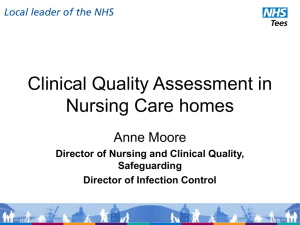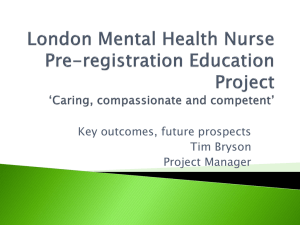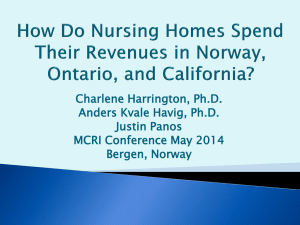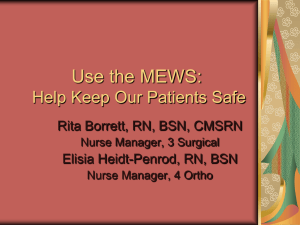Prepare for and undertake physiological measurements
advertisement
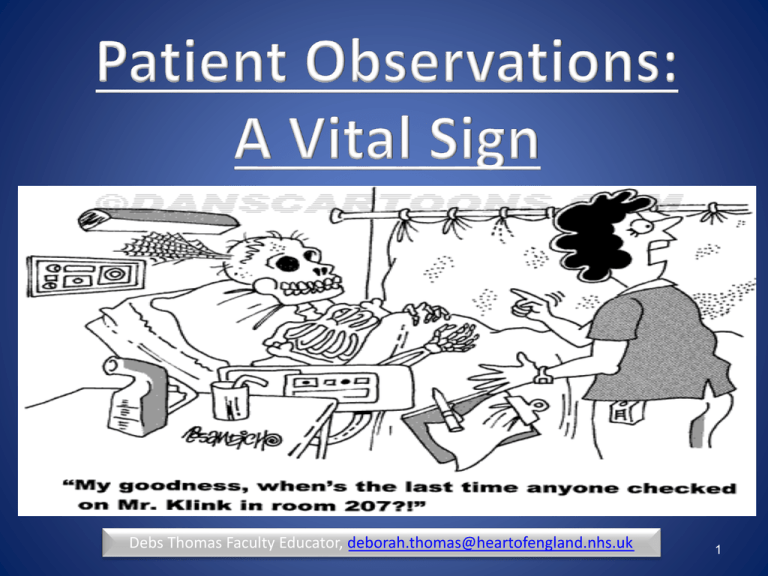
Debs Thomas Faculty Educator, deborah.thomas@heartofengland.nhs.uk 1 Please note ...... This workshop is not an observations’ training session. Please speak to your manager if you feel you require more training. Use the ‘further learning opportunities’ suggestions to develop your learning. 2 Intended Learning Outcomes Explain why observations are taken. Discuss the role of the Healthcare Assistant (HCA) when taking observations. Identify how to take a manual blood pressure. Demonstrate how to perform a manual blood pressure. 3 Observations Temperature Pulse Respirations Oxygen saturations Blood pressure Neurological Peak flow Urine output / testing Blood glucose testing 4 Why take observations? Form a baseline Monitor improvement or deterioration Assist diagnosis Provide information about health Monitor treatment 5 Responsibilities of HCAs Possess the right skills and knowledge. Undertake the appropriate training. Communicate effectively. Maintain accurate records. Follow local policies and guidelines. Maintain and develop skills and knowledge. 6 Current observations issues Move away from automated blood pressure devices. Concerns that some healthcare staff are unable to identify deteriorating observations. Early Warning Scores (like MEWS) to be standardised and launched nationally. 7 Blood pressure “Blood pressure can be defined as the force or pressure that the blood exerts on the walls of the blood vessels.” 8 Blood pressure Systolic pressure: The maximum pressure of blood against the wall of the artery, i.e. when the heart contracts. Diastolic pressure: The minimum pressure of blood against the vessel walls, i.e. when the heart relaxes. 9 Blood pressure range ‘Normal’ Adult Bp 100/60 – 140/90mmHg MEWS Systolic Parameter 101 – 199mmHg Low Bp (Hypotension) Systolic ( < less than) <100mmHg High Bp (Hypertension) Diastolic ( > more than) >90mmHg 10 Manual blood pressure Only undertake this task if you have had the appropriate training. Make sure the equipment you use has been serviced by the organisation. Follow local policies and guidelines. blood-pressure-print.pdf 11 Summary Make sure you only undertake the observations you have been trained to do. Your actions must be underpinned by the appropriate skills and knowledge. Report any changes immediately. Document your findings clearly. Follow local policies and guidelines. Keep on learning! 12 Further learning opportunities Heart of England NHS Foundation Trust (HEFT) intranet site: Critical Care Outreach page (MEWS information). Diabetes page (glucose monitoring competency). Faculty of Education page (go to Nursing & Midwifery, then resources, then onto ‘i-skills’, (password iskills). HCDU on the Faculty of Education page (HCA training). Library resources (textbooks, journals, databases). Safety and Governance page (Adult Safety Manual). SBAR page (SBAR quiz and certificate if successful). 13 Further learning opportunities External on-line sites: HEFT- (password is iskills) www.iskills4heft.co.uk Medicines and Healthcare products Regulatory Agency (MHRA) (on-line obs quiz) – www.mhra.gov.uk NHS Choices – www.nhs.uk/ Nursing and Midwifery Council – www.nmc-uk.org Nursing Times – www.nursingtimes.net/ Resuscitation Council UK – www.resus.org.uk Royal College of Nursing – www.rcn.org.uk Skills for Health – www.skillsforhealth.org.uk 14 Adult Modified Early Warning Score Score / Categories Respirations O2 Saturations 3 2 1 0 1 2 3 - Less than 8 (a minute) - 9 - 16 17 - 20 21 - 29 30 or more (a minute) - - - 94% or more 90 - 93% 85 - 89% Less than 85% Less than 40 (a minute) 41 - 50 51 - 100 101 - 110 111 - 129 130 or more (a minute) Less than 70 (mmHg) 71 - 80 81 - 100 101 - 199 - - - - Less than 35 (°C) 35.1 - 36 36.1 - 37.6 37.7 - 38.2 38.2 or more - - - New Confusion / Agitation Alert Voice Pain Unresponsive - - - No concerns 21 – 35 ml (an hour) 1 – 20 ml (an hour) Nil Heart Rate Systolic Blood Pressure (SBP) Temperature N-AVPU Urine 15 SBAR SBAR Stages S B A R Actions Situation • Your name • Your ward/department • Why you are calling Background • Patient diagnosis • Patient history • Patient treatment Assessment • Your assessment of the patient’s condition in relation to your concerns Recommendation • What actions you want from the call/conversation • The timescale for action 16 References and further reading • • • • • • • • Dougherty, L . Lister, S. (2008) The Royal Marsden Hospital Manual of Clinical Nursing Procedures. 7th Edition. Oxford; Wiley-Blackwell. Higgins, Y. et al. (2008) Promoting patient safety using an early warning scoring system. Nursing Standard: 22: 44, pp 46-48. Jevon, P. (2007) Blood Pressure Measurement: Part One Taking and Manual Reading. Nursing Times: 103: 18, pp 26-27. Mackenzie, M. Spedding, R. Creedon, K. (2010) Pulse Measurement in Adults. Heart of England NHS Foundation Trust, www.iskills4heft.co.uk. Lewis, S. (2011) Hospital staff miss danger signs in deteriorating patients. Nursing Times. (Retrieved 14.04.12) www.nursingtimes.net/nursing-practice/clinicalspecialisms/cardiology/hospital. Mackenzie, M. Spedding, K. (2010) Respirations Recording. Heart of England NHS Foundation Trust, www.iskills4heft.co.uk. Mahoney, P. (2008) Manual Blood Pressure Measurement. (Retrieved 10.03.1 1). www.cetl.org.uk Mains, J. et al. (2008) Measuring Temperature. Nursing Standard: 22: 39, pp 44-47. 17 References and further reading • • • • • • • Peters, C. Bateman, J. (2009) How to be a better HCA: Measuring Blood Pressure. British Journal of Healthcare Assistants (Volume and Issue numbers missing). Rawlings-Anderson, K. Hunter, J. (2008a) Monitoring pulse rate. Nursing Standard: 22: 31, pp 41-43. Rawlings-Anderson, K. Hunter, J. (2008b) Respiratory Assessment. Nursing Standard: 22: 41, pp 41-43. Shuttleworth, A. (Ed) (2004) Monitoring and Assessment. London; Nursing Times and Emap Publications. Spedding, R. Creedon, K. Mackenzie, M. (2010) Blood Pressure recording using noninvasive automated sphygmomanometer. Heart of England NHS Foundation Trust , www.iskills4heft.co.uk. Spedding, R. Creedon, K. Mackenzie, M. (2010) Pulse Oximetry Reading (O2 Saturations). Heart of England NHS Foundation Trust, www.iskills4heft.co.uk. Spedding, R. Creedon, K. Mackenzie, M. (2010) Temperature Recording. Heart of England NHS Foundation Trust, www.iskills4heft.co.uk. 18

